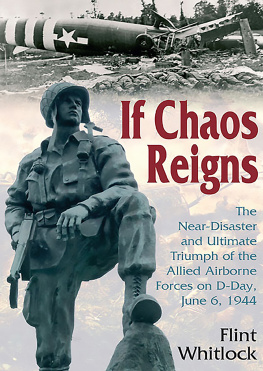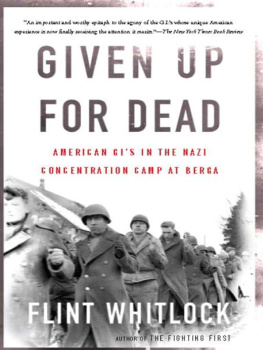If Chaos Reigns
The Near-Disaster and Ultimate Triumph of
the Allied Airborne Forces on D-Day,
June 6, 1944
By
Flint Whitlock

All rights reserved under International and Pan-American Copyright Conventions. By payment of the required fees, you have been granted the non-exclusive, non-transferable right to access and read the text of this ebook onscreen. No part of this text may be reproduced, transmitted, downloaded, decompiled, reverse engineered, or stored in or introduced into any information storage and retrieval system, in any form or by any means, whether electronic or mechanical, now known or hereinafter invented, without the express written permission of the publisher.
Copyright 2011 by Flint Whitlock
ISBN: 978-1-4804-0663-6
Permission has been granted to quote from the following sources:
From Boys of the Clouds: An Oral History of the 1st Canadian Parachute Battalion 19421945, by Gary C. Boegel, 2005 by Gary C. Boegel.
From Crusade in Europe, by Dwight D. Eisenhower, 1948 by Doubleday. Used by permission of Doubleday, a division of Random House, Inc.
From Down to Earth: The 507th Parachute Infantry Regiment in Normandy, by Martin K. A. Morgan, 2004 by Martin K. A. Morgan.
From On to Berlin, by James M. Gavin, 1978 by James M. Gavin. Used by permission of Viking Penguin, a division of Penguin Group (USA) Inc.
From Men of the Red Beret, by Arthur Max, 1990 by Arthur Max. Used by permission of Arthur Max.
From The Day the Devils Dropped In, by Neil Barber, 2004 by Neil Barber.
From The Filthy Thirteen, 2008, American Valor Quarterly, a publication of the American Veterans Center, Tim Holbert, executive director.
From The Story of a Soldier: Edward S. Mehosky, Colonel (Ret.) U.S. Army, Infantry, from Private to Colonel: 19401971, by Ivan P. Mehosky, 2006 by Ivan P. Mehosky.
From Time Out for Combat, by Otis L. Sampson, 2005 by Otis L. Sampson.
From the website www.6juin1944.com, 2010 by Patrick Elie.
From the website www.pegasusarchive.org, 2010 by Mark Hickman.
Cover photo of the Iron Mike paratrooper statue at La Fire Bridge, Normandy, courtesy of Neal Fausset.
Casemate Publishing
908 Darby Road
Havertown, PA 19083
www.casematepublishing.com
This edition distributed by Open Road Integrated Media
345 Hudson Street
New York, NY 10014
www.openroadmedia.com

CONTENTS
Chapter 16: Shootout at the W-X-Y-Z Complex, the
Fight for Brcourt Manor, and Other Skirmishes
FOREWORD
OUR LADY OF LOURDES Cemetery in Slidell, Louisiana is small and sits a block away from Bayou Bonofouca amid live oaks draped in Spanish moss. Of its 200 graves, one headstone stands out by virtue of an American flag that is always theremonth after month, season after season. The little flag marks the final resting place of George Baragona, a Slidell native whose life ended violently during the closing weeks of its 25th year. The headstone leaves only a few clues regarding the circumstances of his death, but the likeness of a pair of U.S. Army parachutist's wings and the words 507 P.I.R., 82nd Airborne Div.K.I.A. D-Day June 6, 1944 offer at least a basic overview.
George Baragona met his fate far from home on a hilltop in Normandy next to an old Roman Catholic Church that was never supposed to be a battlefield. It happened on June 11th, not D-Day, June 6th (as his headstone says) and it happened in a village called Graignes. As the opposing sides of the Normandy battle struggled during the Sunday after D-Day, a vicious battle swept over this village and reduced it to ruins. But the dramatic last stand of U.S. soldiers on that hilltop and the consequent destruction of Graignes is a story that existed outside of the traditional narrative of the D-Day invasion for many decades. With so many thousands of remarkable human dramas unfolding simultaneously during an epic battle, some D-Day stories achieved legendary status while others were practically forgotten. Historians needed those decades to sort out the details and begin bringing these stories to light.
In the example of George Baragona and the battle of Graignes, the story that only recently emerged is one of a mission gone horribly wrong from the start. It is a story of 186 men dropped 20 miles south of their intended drop zone during the largest mass tactical airborne operation the world had yet seen. It is a story of resolute officer leadership under the most challenging circumstances imaginable and individual bravery in the face of modern combat. They were outnumbered, behind enemy lines, and they faced a highly skilled enemy determined to push the Allied invasion back into the sea. Despite the odds stacked against them, they held their positions until the bitter end with many, like George Baragona, paying for that Norman hilltop with their lives.
But Graignes is not alone among the stories of great drama that played out on the drop zones, landing zones and in the hedgerows of the Normandy invasion. The general character of the combat experienced by Allied airborne forces throughout the battle was in and of itself dramatic, intense and decisive. This subject, sensitively chronicled by Flint Whitlock in the chapters that follow, has been approached by many authors in a segregated and exclusive way. But with If Chaos Reigns: The Near Disaster and Ultimate Triumph of the Allied Airborne Forces on D-Day, June 6, 1944, the subject has at last been organized using an inclusive structure.
As a former U.S. Army officer and paratrooper, the author has a unique understanding of airborne operations that thoughtfully informs his examination of the topic. This, his latest book, meaningfully contributes to the existing scholarship of the Second World War by providing a synthesis combining U.S., British, and Canadian airborne operations into a single, coherent narrative. Although these operations have been dealt with separately by countless previous titles, it is only when they are analyzed in the aggregate that the various crucial aspects of their contribution can be fully evaluated. Flint Whitlock succeeds brilliantly in this undertaking through an astute use of primary sources and an extensive familiarity with a rich body of secondary literature.
Although this book is full of exciting descriptions of combat guaranteed to remind the reader of John Keegan's The Face of Battle (1976), it also reaches a thought-provoking intellectual conclusion. In response to recent writings downplaying their importance, the author advances a powerful argument in defense of the crucial role of Allied airborne forces in Normandy. By emphasizing certain tactical successes that could only have been achieved through the use of vertical envelopment tactics, Whitlock reaches the verdict that the invasion would not have succeeded without the airborne. Commendably, his narrative features not just paratroopers and glidermen but also the true unsung heroes of the airborne: the sky soldiers of the Troop Carrier units that flew the ground forces to battle.
If Chaos Reigns brings the Normandy airborne experiencein all its chaotic totalityinto focus as never before. With a cast of characters that personalizes the story throughout, the book avoids bogging down in a recitation of battalions maneuvering on the battlefield. Although the author handles operational military history details with skill, he nevertheless maintains focus on the individuals who fought and died during the Allied invasion of northern France in June 1944. To Flint Whitlock, the cold, hard, pitiless statistics represented by anonymous casualty figures fail to convey the anguish suffered by each mourning family who lost a sky soldier in Normandy. But men like George Baragona nobly advanced the war against totalitarianism during the summer of 1944 and turned near disaster into ultimate triumph. Flint Whitlock captures their spirit in this book with an eloquence that honors their memory.














